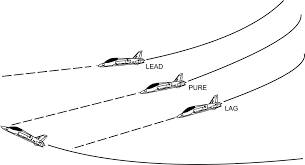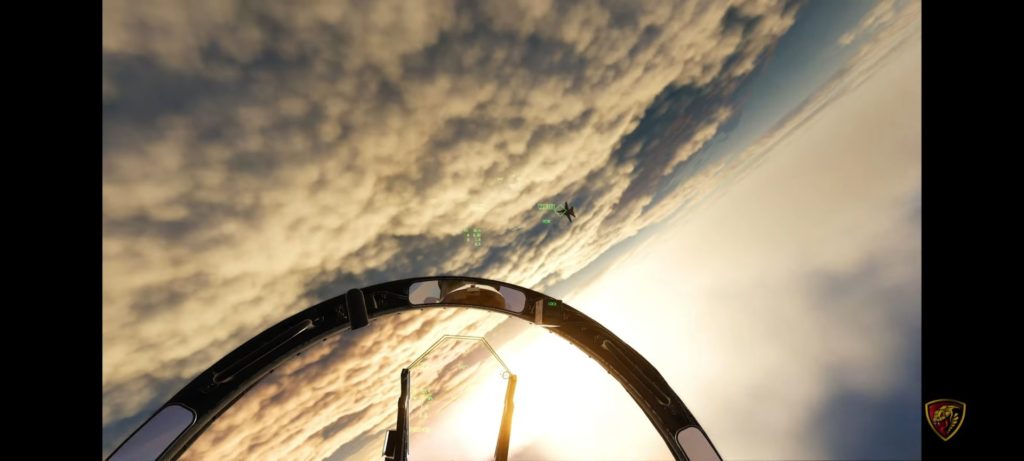DCS World Fly BFM and be Dominant Every Engagement.
DCS WORLD Fly BFM and be Dominant every engagement is a challenge. So, getting to grips with BFM and being dominant every engagement you enter is another mission altogether. You can though, but with the right knowledge! There are many parts to flying basic fighter maneuvers (BFM), so let’s get the basics down first before trying to be more aggressive.

HUD BFM is the Wrong Way to Fly!
What is HUD BFM and why is it a bad? Flying HUD BFM is bad because you will always be trying to pull the target into the HUD, which means you will relentlessly be pulling on the stick so you’re constantly bleeding your valuable energy. This means you expend all your energy achieving little other than trying track the target.
You need patience. Managing your energy is paramount so you can track and eventually kill the target. Learning and practicing this will make you far more successful in BFM combat. If by flying HUD BFM and your able to get a kill quickly then you have done well. Much of the time it will be fruitless and get you killed.
Let’s look at why, then how to fly better, by understanding your aircraft qualities as well as your opponents.
- Joystick / HOTAS – AMAZON.com
- Rudder Pedals – AMAZON.com
- Throttle Quadrant – AMAZON.com
- Gaming Chair – AMAZON.com
- VR Headset – AMAZON.com
Fighter Qualities are Different.
Fighters fall into two distinct categories. These comes down to their original design and what the designer had in mind for the jet from the planning stage. Jets in DCS World can fly BFM and be dominant every engagement if they fight to their own strengths. These strengths or flows are called either a ONE Circle and or a TWO Circle flows. How you fly these flows is what this post is about!


Recognizing ONE Circle Vs TWO Circle.
This is an important aspect of flying your favorite aircraft in DCS World from a Bf-109G to a Modern Jet fighter. The principal remains constant in that a one circle flow is when two jets turn nose to nose at a merge. The nose-to-nose fight tends to suite aircraft that have great high angle of attack qualities (AOA).
It makes this fight a radius fight, where the aircraft can make the smallest circle in the sky should win if allowed to control the fight.
Radius Fighters.
Aircraft that love high angle of attack flying are the F-18C, the Mirage 2000 and the Su-35 to name a few. They all excel in the one circle or radius fight. It gives them a first option to shoot at an opponent and launch weapons by getting their nose around first at the merge. These aircraft by turning in the smallest circle makes them very dangerous.
Sounds like a winner doesn’t it! It certainly can be but, the cost of this fast initial turn is the drag created bleeds the aircraft speed very quickly. Often without altitude to dive and recover energy quickly they can be at a disadvantage to a rate fighter. One big turn can take the aircraft from 350-400 knots to 200 knots and barely flying in a few seconds.
The danger is the ground and once you have used up all your altitude pulling the target into the HUD you’re in the rate fighters regime. Time to die! Is a radius or one circle fighter you want to fly in your next engagement? What will be your choice? Let’s look at rate fighters or two circle fighters next.


Two Circle Rate Fighter.
The two-circle flow is a nose to tail fight where essentially one aircraft chases the other around a 3D circle in the sky. The difference between the two concepts is one is a radius fight where the aircraft with the high angle of attack capability (AoA) is able to turn the smallest circle in the air.
The rate fighter can get around the circle faster than a radius fighter. All aircraft have their advantages so flying yours to its strengths is where you need to fly it.
Rate vs Radius.
The rate fighter is all about how fast in degrees per second it can get around the circle. This requires more patience and discipline to achieve. It is a nose to tail fight. The pilot must maintain the correct corner speed, so the aircraft turn performance is maximized.

The king of two circle in DCS World is the F-16 Viper without a doubt. Aircraft like the F-16 Viper excel and will chase you down relentlessly getting closer and closer to your control zone.

The Control Zone.
The control zone is a 60-degree cone behind the defensive aircraft. If the area where guns and missiles are the most effective and the opponent cannot shoot back. Once you get here the game should be won.
F-16 vs F-18 – How It Could End!
Fighting the F-16 in a merge, the F-18 turns left but the F16 waits a moment and turns left as well creating a two-circle flow. In a two-circle flow if the F-18 does not redefine the fight quickly he will be at a disadvantage immediately. In the first turn he pulls hard to get the Viper into his HUD he will see the Viper just above his nose. If the Hornet pilot pulls hard to get a shot and misses, he will be in trouble even though he is behind the Viper. Hornets cannot match a Viper in a rate fight. It’s just not going to happen if flown correctly.


The Hornet would spend its initial energy getting the nose on target. It will cost it a lot of speed to do this. If it succeeds it can win, but if it misses the opportunity the Hornet is going to be below corner speed most likely, and the Viper will have a speed advantage.
The Hornet is out of a lot of options now for the most part! Pointing its nose down to get energy back to fly its best corner speed takes time. The Viper who is maintained his corner speed will march around the circle from above the Hornet HUD to behind the Hornet in a few circles. Now it dies! It’s inevitable you will lose, Mr. Anderson. (The Matrix- Quote)
Review the Options.
Take a look at the two types of circles again hopefully you will understand this concept, and be able to introduce it to your next mission. Please remember this fighter jet world is three dimensional, so you can rate fight from horizontally to vertically and everything in between.

Visual Identification.
Flying towards the opponent nose to nose initially what you need to do is initiate a turn and see what the opponent does noting the direction of turn is important. In the Viper you merge with a fighter, and he turns left and you turn right you will be in a one circle flow and quickly see the nose of the aircraft pointing back at your nose. In a Hornet if you merge and the opponent turns left, then if you turn left, you will be in a two-circle flow. You will find yourself chasing the other aircraft tail as he will yours.
The Answer to Winning!
The answer to winning is being able to fly in DCS World, fly BFM and be dominant every engagement is going to take time to practice. These concepts are easy to understand and needs your dedication practicing them in DCS World so you can fly BFM and be Dominant Every Engagement.
Rule 1: Keep Tally.
No matter what you must remain visual on your opponent. Keep tally at all times and yes, it’s a task. Flying and looking back over your shoulder which is what you will need to do effectively above all other tasks. If you fly with head tracking this is a lot easier than VR but no matter, you must track the target. The moment you lose tally the opponent you’re going to die!

” Lose sight lose the Fight” It is IMPERITIVE you see the Enemy at all Times!.
Step One to Winning.
It’s all about creating problems for the bandit, managing your closure rate and getting into the enemies control zone. Flying the F-18C or Mig-29 the cockpit has a bow as part of the canopy. The ideal position to maintain the enemy aircraft while turning is to keep the aircraft about a fist height above the bow. The Viper has no canopy bow so it’s about two fists above the top of the HUD.

This positioning of the target ensures you can see it and you will be flying lag pursuit. Lag pursuit will control your closure rate on the bandit so you don’t overshoot and become the target.

Second Winning Tip.
The second part of the equation is always fly to where the enemy cannot kill you. Ideally you will fly to the aircraft’s six o’clock position. Do not fly in front or directly at it. This is all about maintaining control of your closure rate.
Lift Vector.
Maintain your lift vector behind the enemy aircraft six o’clock is another way of creating the same controlled closure rate. Flown well you should transition from this aspect to the target over the canopy bow in time. The lift vector is the vertical line upward out of your seat. Maintaining this concept achieves the same result. A manageable closure rate and ending up behind the target and not overshoot it.
Tip 3 Never Reverse Your Turn.
The target in this Growling Sidewinder video has reversed its turn while being pursued. This is something you should NOT do. You can see the target aircraft is solving the opponents problem for him and flying back into the HUD to be killed. The only time you can reverse your turn to redefine the fight is when the other aircraft cannot see you to react. It has to be timed perfectly to be successful.

Maintain Distance and High Aspect.
It’s very worthwhile maintaining a moderate distance from your target. Missiles have a minimum range that they can kill you, so be conscious of this distance. Experience will teach you hard lessons if you stray too far. Keeping the best distance does not get so close to the target you can see him smile at you. If you get to close controlling range and closure becomes much harder. It will be easier to push you out in front of your opponent to get shot.

- Latest CPU’s Available Now – Amazon.com
- Get a NEW GPU Best Performance – AMAZON.com
- Upgrade RAM Here today – AMAZON.com
- Prebuilt PC Options – AMAZON.com
Author
Brendon McAliece (Aka Gunnie) is a military veteran with 23 years working on Jet Fighters, their weapons systems and ejection seat/module systems as well as munitions and R&D. Involved with flight simulation since the 1980s, he has flown all the major flight simulators over the years.
He is an Australian expat who has lived in Malaysia, UK, Saudi Arabia and more recently Thailand. He is a multi-lingual blogger who loves to share his life experiences here on LetsFlyVFR.com and DreamingGuitar.com, with his lifestyle and Travel experiences Blog plus his Dreaming Coffee website.
Learn More @ DreamingGuitar.com – DreamingCoffee.com – LetsFlyVFR.com
( HOME – BLOG – SHOP – ABOUT )
As an Amazon affiliate I may benefit from qualifying sales.









